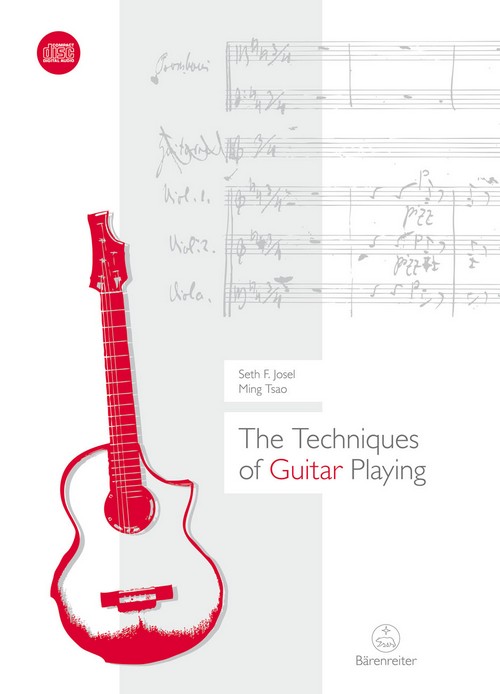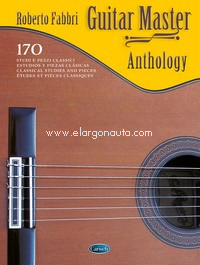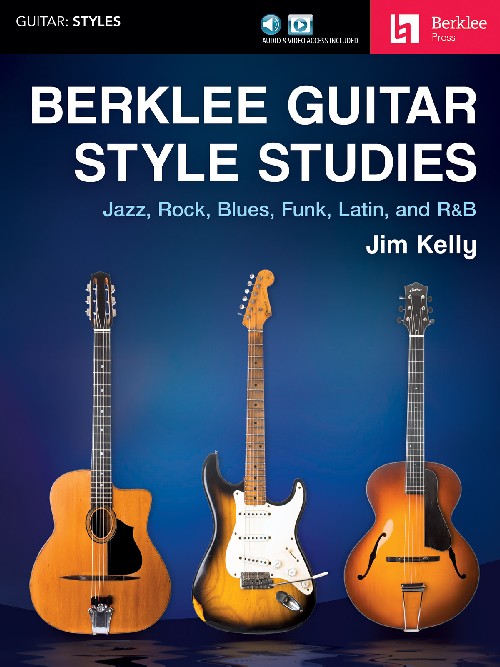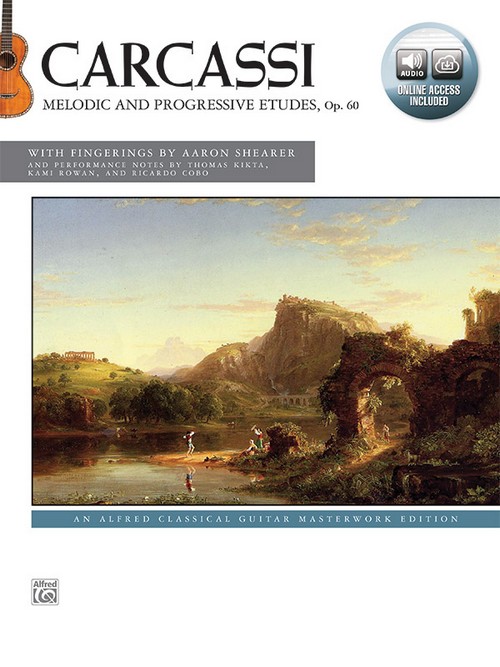
The Techniques of Guitar Playing. Contemporary Performance Techniques for the guitar
Josel, Seth F.
;Tsao, Ming
Bärenreiter. 2015Ficha técnica
- EAN: 9783761822432
- ISBN: 978-3-7618-2243-2
- Editorial: Bärenreiter
- Fecha de edición: 2015
- Encuadernación: Rústica
- Dimensiones: 21x29
- Idioma: Inglés
- Nº páginas: 235
Disponible en breve
Sin stock. Si se pide hoy, se estima recibir en la librería el 02/05/25¡GASTOS DE ENVÍO GRATIS!
PVP. 69,90€
Añadir a la Lista de deseos
This book, co-written by guitarist Seth F. Josel and composer Ming Tsao, provides a comprehensive survey of contemporary performance techniques on the classical guitar. It was inspired by a new generation of solo guitarists whose extraordinary technical and virtuosic skills have paved the way for a new understanding of instrumental performance practice.
Detailed explanations are given for the instrument?s technical potential within the historical context of traditional guitar technique. Composers will be interested in the in-depth analyses of contemporary guitar literature, featuring many examples of chamber and ensemble music.
Four main chapters describe:
- Techniques of the right and left hands
- Special harmonies and percussive techniques
- The main instruments of the guitar family and their potential
- Possible ways of notating contemporary guitar literature
The examples discussed in the book are complemented by an enclosed CD and detailed charts on multiphonics, bitones, and percussion techniques.
CONTENIDO:
Preface
Acknowledgments
1- Guitar Basics
1.1 Essential components of the guitar
1.1.1 Strings
1.1.2 Soundboard
1.1.3 Soundbox
1.1.4 Fretboard
1.2 How a guitar tone is produced
1.3 Traditional and nontraditional tunings . ,
1.3.1 Historical tunings
1.3.2 Equal tempered tunings
1.3.3 Microtonaltunings
1.3.4 Tunings based on the harmonic series orjust intonation
1.3.5 Tunings changed during a performance. .
1.4 Abbreviations and symbols for fingers and fingering positions
1.5 Notation basics
1.5.1 Traditional Expressive Markings ,
1.5.2 Multiple staves
1.5.3 Tablaturenotation
1.5.4 Action stave for the RH position
1.6 Fretboard chart
1.6.1 Negotiating the fretboard
1.7 LH techniques
1.7,1 Stopped notes and open strings
1.7,2 Single notes to chords
1.7.3 Beyond the fretboard
1.7.4 Clusters
1.7.5 Polyphonic textures or "impressionistic polyphony"
1.7.6 Other ways of stopping notes on the fretboard
1.7.7 Barré positions
1.7.8 Slurs-hammer-on/pull-off
1.7.9 Extensions of the pull-off
1.7.10 Vibrato
1.7.11 Trills-on one or two strings
1.7.12 Glissandi/Portamenti
1.7.13 String bending
1.8 RH techniques
1.8.1 RH patterns: arpeggiation (Giuliani,Tárrega, Pujol)
1.8.2 RH strokes: tirando vs,apoyando
1.8.3 Tremolos,
1.8.4 Cross-stringtrill
1.8.5 RHtimbre
1.8.6 Filtering
1.8.7 Strumming
1.8.8 Pizzicato or RH muting
1.8.9 Bartók pizzicato/snap pizzicato
1.8.10 Plectrum
1.9 Orchestrating for the guitar: key historical works
- 2 Guitar Harmonics
2.1 What are harmonics?
2.1.1 Harmonic series
2.1.2 How are harmonics generated on a guitar?
2.2 Harmonics on the open strings of a guitar.
2.2.1 How high?
2.2.2 Location of open string harmonics
2.2.3 Harmonics on different strings
2.2.4 Harmonic dilemma in Webern's Drei Lieder, op. 18
2.2.5 Scordatura
2.2.6 RH plucking techniques for harmonics
2.2.7 Harmonics produced by the LH alone
2.3 Examples from the literature
2.3.1 Use of harmonics as sole material for a composition
2.4 Notation of harmonics
2.4.1 Inclusion of the string number
2.4.2 Harmonics notated at concert pitch
2.4.3 Harmonics notated as fingered pitches
2.4.4 Brief overview of harmonics notation
2.4.5 More notational confusions
2.5 Half harmonics
2.6 Notation of natural harmonics and half harmonics
2.6.1 Notation of harmonics on scordatura strings
2.7 Multiphonics
2.7.1 Positions of selected multiphonics on the fretboard
2.7.2 Corresponding multiphonic chords
2.7.3 Examples from the literature
2.8 Artificial harmonics
.
2.8.1 Timbral differences
2.8.2 Examples from the literature
2.8.3 Notation of artificial harmonics
2.8.4 Extensions of artificial harmonics
2.8.5 Notational reframing
2.9 "Attackless" harmonics
2.10 Guitar harmonics in context
- 3 Guitar as Percussion
3.1 Historical precedente
3.1.1 Contemporary examples: LH tapping
3.2 RH tapping
3.2.1 Tapping combinations
3.2.2 Case study: Rolf Riehm's Toccata Orpheus
3.2.3 Uripitched tapping
3.3 Bi-tones
3.3.1 Bi-tonechart
3.3.2 Producing the auxiliary pitch of a bi-tone , .
3.4 Battuto
3.5 Guitar as percussion instrument
3.6 Tambour
3.6.1 Examples of tambour
3.6.2 RH muting as a percussive effect
3.7 Golpé
3.7.1 Possible areas on the guitar to execute a golpé
3.7.2 Diversified golpé
3.8 Percussive map
3.8. 1 Further extensions of golpé
3.9 Tamburo
3.9. 1 Examples of tamburo
3.10 Brushing/Rubbing/Scraping
3.10.1 Güiro/"Guero" actions
3.11 String buzz
3.12 Notational conventions
3.13 Foreign objects
3.13.1 Slide
3.13.2 Other foreign objects: bows, beaters, thimbles, etc,
3.13.3 More notational conventions
3.13.4 Beaters and mallets
3.13,5 Miscellaneous objects
3.14 Prepared guitar
3.14.1 Capo tasto
3.14.2 Repertoire
3.14.3 Other preparations
3.14.4 Guidelines for guitar preparation
3.14.5 Re pertoire
3.15.0 Guitar as percussion in context
- 4 "All in the Family": The Acoustic Guitar's Relatives
4.1 Nineteenth century instruments
4.1.1 Octavine guitar
4.1.2 Terz guitar
4.2 Deviation from the six strings: the seven-strings guitar and the ten-string guitar/décacord. .
4.3 Double-neck guitars
4.4 Ukulele
4.5 Acoustic steel-string"flat-top" guitar
4.5.1 Ebow
4.5.2 Acoustic-electric guitar
4.5.3 Twelve-string acoustic guitar
4.4.5.4 Resonator guitar/slide guitar/Dobro® .. , .
5 Appendices
5.1 Technical notes
5.1.1 Helmholtz resonator. ..
5.5.1.2 Multiphonic analysis
5.1.3 Bi-tone formula for yielding hertz
5.2 Diverse preparations and descriptions from Yates and Elgart
5.3 CD Track List
5.4 Bibliography
5.4.1 Solo works for the guitar
5.4.2 Guitar solo with ensemble or orchestra
5.4.3 Chamber music with guitar
5.4.4 Large ensemble/orchestral/choral/stage work with guitar
5.4.5 Literature cited
5.4.6 Historical documents
5.5 Index
5.6 About the authors




